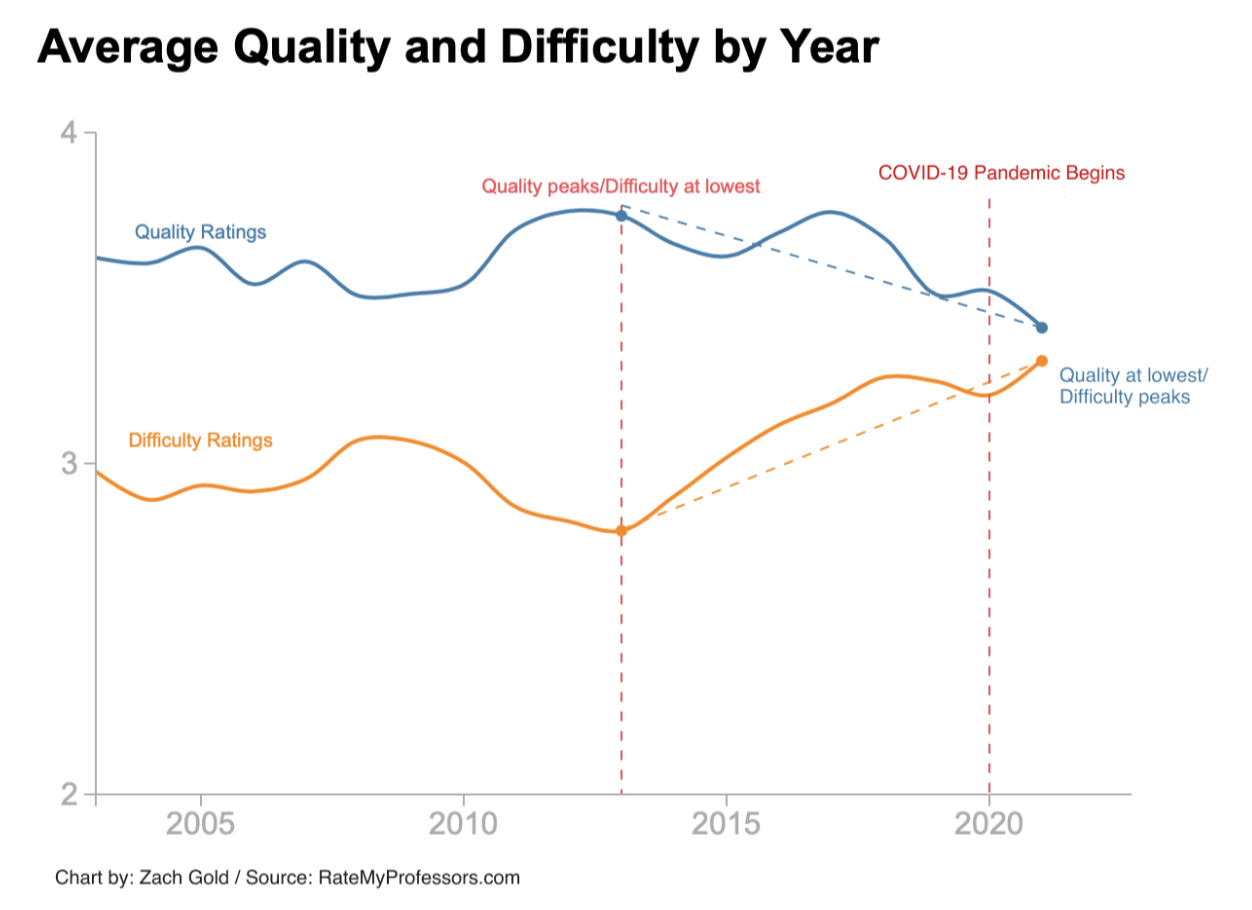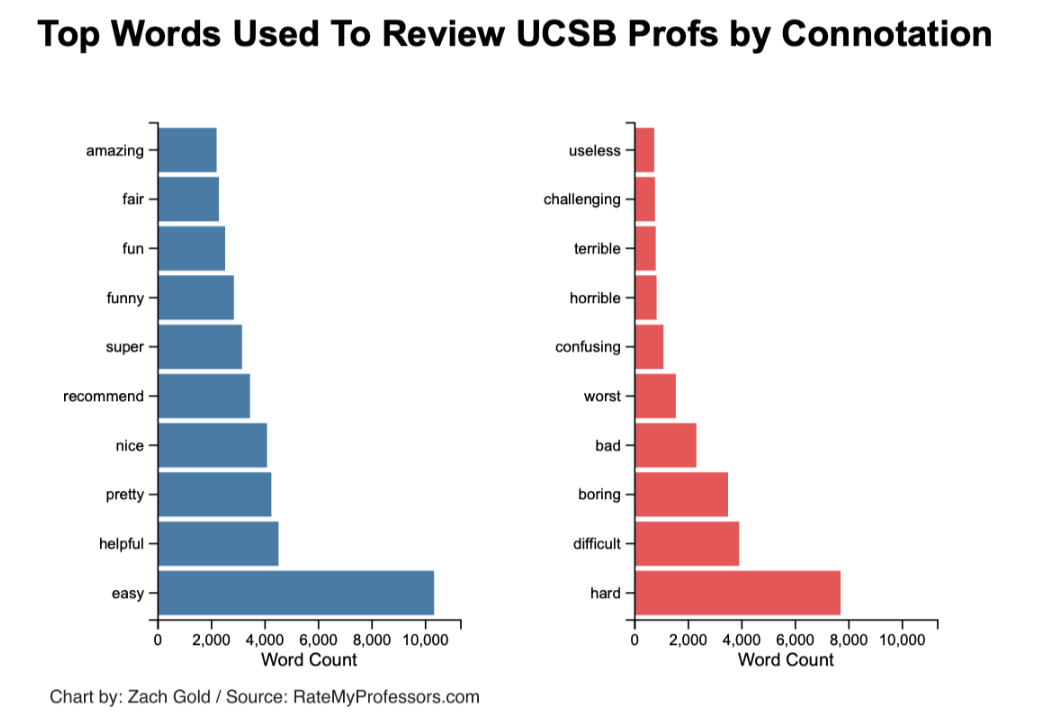Introduction
When choosing classes to enroll in, students flock to RateMyProfessors.com every year, an online database of more than 19 million reviews about 1.7 million professors that has served as a resource to guide course selection for students worldwide. The Daily Nexus Data Team used a Python script that automatically visited each UC Santa Barbara professor’s rating site and scraped information on each review available. Using this method, the Daily Nexus Data Team collected 48,926 reviews from 2,913 professors and lecturers dating back to 2003.
Side note: The scraper captured 90-95% of reviews left for professors at UCSB.
How does the quality and difficulty of ratings vary over time? 
In addition to reviews left by students, the Rate My Professors (RMP) website collects two key metrics from users: quality of the professor and difficulty of their teaching, both recorded on a scale of 1-5. The following data visualize the trends in how the quality and difficulty of ratings changed over time by taking the average rating of all professors in every department at UCSB. In 2013, the difficulty of professors reached a minimum rating of 2.8 out of 5 stars, corresponding with a relatively high rating in quality. As the difficulty of teaching begins to rise after 2013, the quality of teaching follows a decreasing trend. Overall, there is a pattern where a lower difficulty corresponded with better ratings in quality. In 2020, the quality of teaching, which had increased the year prior, begins to decrease while the difficulty reaches a peak, likely due to remote learning.
Fourth-year psychological & brain sciences major Nishay Chitale was homeschooled and took courses at a city college before coming to UCSB, giving him six years of experience with RMP. He said that the transition to remote learning in 2020 affected the quality of teaching he was receiving from his courses.
“In terms of the quality, it depended on the professor. With every course, the professor is the biggest determinant for the quality, but I felt like it was magnified during remote learning,” Chitale said. “Bad professors were even worse, while good professors were able to maintain a relatively similar quality to in-person learning.”
Student Perspective
The Data Team released a survey on the Daily Nexus Instagram to gauge student perspectives on the RMP site. 52 students responded from varying majors and years.
On a scale of one to five, 84.6% of students marked the four (likely) and five (very likely) categories when assessing the likelihood of a professor’s RMP quality rating affecting their decision to take a course. When assessing the RMP difficulty rating of a professor, 55.8% marked four and five. These results show that students value the quality rating of a professor over the difficulty when choosing courses.
While a significant percentage of students weigh RMP ratings heavily when choosing courses, there is also a bias to take into account. Chitale said that the general ratings give you a basic sense of what the course is like, but there are confounding factors like the professor’s teaching style, which could vary in preference among students. For example, if a professor does not use slides, some students who are visual learners may find his teaching of poor quality, while others enjoy the auditory focus of the course.
“If you just look at the score, then it’s not going to be as helpful,” Chitale said. “What I tend to do is I’ll look at the bad reviews and see what exactly about the professor is bad.”
Other students, such as fifth-year writing major Chace Duma, share similar opinions about the effectiveness of the reviews on the site. “I read over them just because some of them seem a little hyperbolic sometimes, but for the most part, I think the collective trend of all the reviews can be taken more than just like what an individual review says,” Duma said when asked about the genuineness of the reviews. Even though the site provides an additional lens into courses and professors, many students still have reservations about RMP or opinions as to how the site could improve user experience.
Based on our interviews, some features that students suggested for RMP were ratings for teaching assistants (TAs) that lead sections and labs or filtering a professor through the courses they have taught. “I don’t know if that would really be super feasible, considering TAs will teach for a limited amount of time,” Chitale adds.
What are the top positive and negative words used in ratings?
Using Bing Liu’s “Opinion Lexicon,” — a list of words that indicate a positive or negative opinion — the most common words for each category were isolated. The words “easy” and “hard” top the charts of their respective categories with “easy” appearing over 10,000 times and “hard” almost 8,000 times. Aside from those two descriptors, most of the common positive and negative words only appear less than 4,000 times, displaying a common trend towards the usage of “easy” and “hard.”
Which departments have the highest number of reviews?
Looking at the UCSB ratings for each department, the Department of Mathematics has the most reviews with over 5000. Almost all STEM majors offered at UCSB require at least one mathematics course in the major requirement. Additionally, the Area C General Education requirements make mathematics a common option for students to take. Among the top 10 most reviewed departments, there is an even number of STEM and humanities/social science departments.
Conclusion
Overall, RMP is a highly valuable site given to students in providing an additional layer of information when evaluating courses and professors. Although the reviews themselves are not a definitive evaluation of the course or professor, it provides a useful tool when students keep potential biases of the reviews in mind and seek additional advice from upperclassmen or the professor.

















